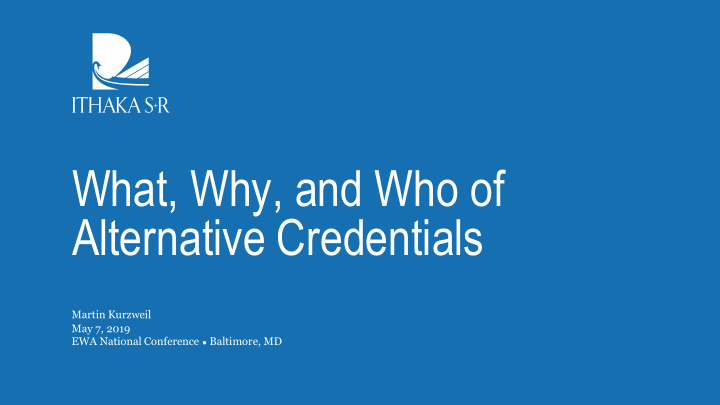



What, Why, and Who of Alternative Credentials Martin Kurzweil May 7, 2019 EWA National Conference ● Baltimore, MD
Certificates – awarded at end of period of study; credit and non- credit Certifications/licenses – awarded based on demonstration of What are competency, usually with exam alternative Apprenticeships – structured work-based learning experience credentials? Coding boot camps – short-term course in a tech skill MOOCs – large-enrollment online courses, sometimes bundled into micro-credentials Badges – digital representation of a skill or accomplishment 1
Certificates – ~1 million awarded by Title IV providers in 2015; ~600,000 by non-Title IV providers in 2013 How many Certifications/licenses – 21% of adults held one or the other in 2016 alternative Apprenticeships – 500,000 registered apprenticeships in 2016 credentials? Coding boot camps – 18,000 completers in 2016 MOOCs – 35 million enrolled, 6% of courses completed in 2016 Badges - ???? 2
The potential: faster, cheaper, directly job-related How valuable Labor market value varies by field, type, and provider: are alternative Cosmetology <<< IT credentials? Certificates < certifications/licenses For-profit college < not-for-profit college < corporate/industry 3
Majority of certificate programs are sub-baccalaureate Certifications, licenses, Who earns apprenticeships, boot camps, and MOOCs cater to those with alternative undergraduate degree Lower-earning certificates credentials? disproportionately Black/Latinx women Higher-earning certificates, certifications/licenses, boot camps disproportionately white men 4
Data are limited & quality assurance is patchy Missed signals between employers and candidates Challenges Lower-income, first-generation, minority opportunity seekers may be least able to navigate & Opportunities Large employers are highly motivated Interesting partnerships among higher ed, employers, and other providers Bi-partisan federal/state interest 5
Thank You Martin Kurzweil Director, Educational Transformation Program Martin.Kurzweil@ithaka.org Twitter: @martinkurzweil http://sr.ithaka.org
Appendix
Source: Brown & Kurzweil, The Complex Universe of Alternative Postsecondary Credentials and Pathways , American Academy of Arts & Sciences, 2017.
Source: Brown & Kurzweil, The Complex Universe of Alternative Postsecondary Credentials and Pathways , American Academy of Arts & Sciences, 2017.
Source: Brown & Kurzweil, The Complex Universe of Alternative Postsecondary Credentials and Pathways , American Academy of Arts & Sciences, 2017.
Source: Brown & Kurzweil, The Complex Universe of Alternative Postsecondary Credentials and Pathways , American Academy of Arts & Sciences, 2017.
Recommend
More recommend